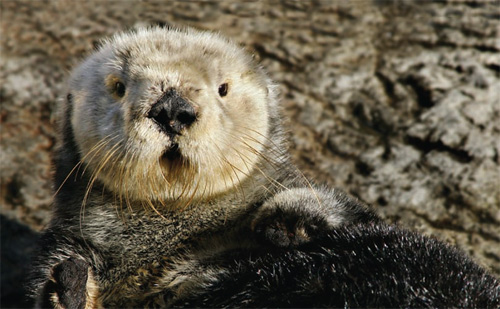
In the late 1970s, David and Lucile Packard commissioned a feasibility study on a proposed aquarium on Cannery Row. Researchers thought such an attraction might draw 350,000 visitors annually, recalls Dr. Steve Webster, Monterey Bay Aquarium cofounder and retired director of education. Plans moved forward, and doors opened on October 20, 1984.
In its first year alone, the Monterey Bay Aquarium welcomed 2.37 million guests.
“The study missed, but fortunately it missed in the right direction,” Webster laughs.
Twenty-five years later, the aquarium has hosted more than 44 million visitors and currently counts 250,000 people as members. Approximately 35,000 animals and plants are housed there; some 425 full- and part-time employees, plus 1,000 volunteers, keep things running. Another 100 people work for the Moss Landing-based Monterey Bay Aquarium Research Institute (MBARI).
The original aquarium concept grew from a discussion among marine biologist friends, including Webster, then a San Jose State University professor, David Packard’s daughter, Nancy Burnett, and Stanford University Hopkins Marine Station faculty members Robin Burnett and Charles Baxter. Packard’s daughter Julie, now the aquarium’s executive director, later joined the efforts, and David and Lucile Packard funded initial construction with a $55 million personal gift.
Though the aquarium was an immediate hit with visitors, resulting traffic and parking issues frustrated neighbors in Monterey and Pacific Grove.
“I think we were all surprised—the aquarium, the city, the entire community—by how extraordinarily popular it was,” says Clyde Roberson, Monterey’s mayor when the aquarium opened. “That led to some great collaborative efforts between the aquarium and the city.”
In addition to supporting construction of the Cannery Row parking garage, aquarium leaders partnered with Monterey officials and Monterey- Salinas Transit to create a visitor shuttle between downtown Monterey and Cannery Row. Meanwhile, with an average of 1.8 million annual visitors, the aquarium’s facility and program expansion continued. Deep-sea research through MBARI began in 1987. In 1996, the $57 million Outer Bay wing opened. The Seafood Watch program launched in 1999, and entryway and original aquarium gallery renovations took place in 2004 and 2005.
The aquarium owes its instant and ongoing popularity partly to its location, believes Vice President of Communications Hank Armstrong, who started working at the institution six months before it opened.
“It’s almost as if it rises out of the bay itself,” he says. “It was positioned, although we didn’t know it at the time, to be much more successful than most people ever thought.”
Exhibit planners captivated guests from the start by redefining aquarium design. Displays were organized by habitat instead of by individual species. Designers traded traditional small, square tanks for large, multi-faceted exhibits that encouraged viewing from many angles, and touch pools invited visitor interaction. The three-story Kelp Forest, which thrives thanks to a wave motion system designed by David Packard, was the first and largest living kelp forest community created at an aquarium. And, an innovative open seawater system still draws water directly from the Monterey Bay. That means spores and larvae flow in and grow in the exhibits, making displays a living extension of the outside.
“What seem like small things now were, at the time, improvements on a really dated concept,” Armstrong points out. “What guests got when we opened was something that vastly exceeded expectations. People said, ‘Wow!’ and word of mouth quickly spread.”
Just as the aquarium fascinates visitors, so does it educate and encourage them to think about sustainable seafood, marine policy, animal welfare and related topics. The aquarium’s mission, “To inspire conservation of the oceans,” shapes popular events such as Cooking for Solutions, an annual festival focusing on responsible food choices and ocean health, as well as ongoing activities for children, families and teachers. Some 80,000 children visit the aquarium each year just through free school programs.
Ariel Towber, a Salinas High School graduate who completed a marine biology degree this spring, once was one of those schoolchildren. She went from petting aquarium starfish as a toddler, to snorkeling and taking behind-thescenes tours while in middle school, to rubbing shoulders with scientists as a Student Oceanography Club participant.
“They always let us see ‘real’ science. They didn’t ever try to dumb it down, and they always made it fun,” she says. “Scientists there brought us up to their level and challenged us. I think kids react really well to that.”
Towber credits aquarium staff for influencing her career path and, ultimately, she hopes to return to the institution.
“For as long as I can remember, I’ve wanted to work for the Monterey Bay Aquarium. Maybe I’d be an aquarist or an education person or a diver or a researcher. I don’t know—I just love the Monterey Bay Aquarium, and I want to get back there,” she says. Dr.Webster believes the aquarium achieves its mission each time a guest is inspired to act, whether that’s choosing a marine career or simply discussing lessons learned during a visit.
“The aquarium is having a significant effect not just in making people aware of ocean conservation issues, but also in getting them concerned about doing something. I think people are paying a little more attention to climate change and global warming, maybe because now they understand a little bit more about the ocean,” he says.
The Monterey Bay Aquarium celebrates its silver anniversary on October 17-18, 2009. To view a complete event schedule, along with a timeline featuring images and accounts from the past 25 years, visit www.montereybayaquarium.org.